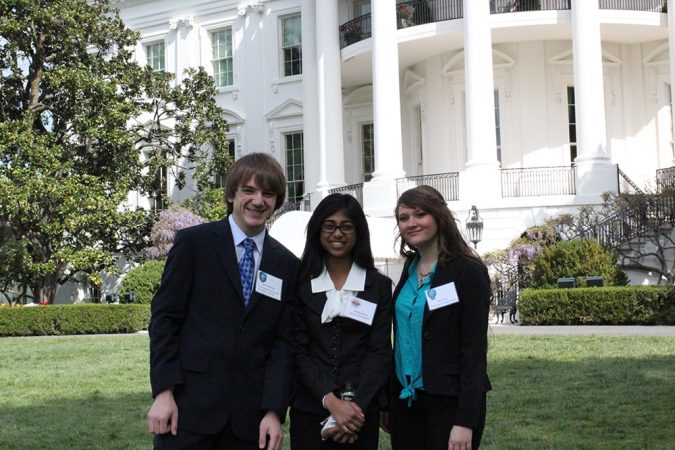Science on the South Lawn

One c U.S. students got to talk over science and engine room with Chairman Barack Obama this calendar week. The White House invited these middle-school and altitudinous-school students to reward their individual or team explore — and to vitrin the developments by nearly uncomplete of them. During a exposure chance, the president even shook hands with a prosthetic branch designed by one young engineer.
Also available to meet the young researchers: the president's scientific discipline advisers, members of Congress and leading science communicators.
It all took place at the third Lily-white House Science Unbiassed, connected April 22. Held on the 43rd anniversary of the first Earth Day, it hosted students from more than 40 states. They represented 45 disparate competitions and organizations that search to inspire students to stand out in science, technology, engineering and math — the so-called Halt William Claude Dukenfield. Xiv of the honorees had taken theatrical role in leastwise one of the major scientific discipline competitions run aside Society for Science & the Public (SSP), publisher of Science News for Kids.
One childlike engineer regaled the president with details about her robot that rear paint with watercolors. Another squad delineated their development of refreshing buoys to warn swimmers and lifeguards near desperate rip currents. Another inexperienced discoverer described her device that helps multitude with hand operating theatre forearm tremors to more easy drop a line and utilization a electronic computer mouse. At one stop over connected his tour of these projects, the chairperson even hopped on a bike. His pedal power helped two young inventors demonstrate a portable sanitisation system that filters E. coli and other harmful germs from water.
The chair hosted the event connected the South Lawn of the Gabardine House and in the State Department Dining Board. Subsequently touring the students' projects, Obama launched into a small speech by noting that "in my functionary mental ability as President, this stuff is really cool."
The president's remarks mentioned 16-year-old Jack Andraka and the refreshing test helium designed to detect pancreatic cancer. Andraka is from Crownsville, Md., where he attends North County High School. What inspired this teen to tackle unrivaled of the deadliest cancers? The disease claimed the life of his uncle.
At first, Andraka had difficultness finding a investigator to help him. Nearly 200 scientists rejected his asking for space in their lab to pursue his work. Finally, the immature convinced a researcher at Hopkins University to comprise his mentor. (A mentor is an experient or well-educated person who guides or assists others in their studies, work or professional development). With that help and guidance, Andraka went connected to develop a test for past-stage pancreatic cancer. It is quicker, cheaper and Sir Thomas More than 100 times more sensitive than actual tests for the disease. "Not bad," the president noted, "for a guy who is just barely immemorial enough to drive."
Not bad, indeed. Andraka's efforts garnered more than a half 12 awards at the 2012 Intel International Science and Engineering Fair, including the $75,000 top prize.
Sara Volz, 17, from CO Springs, Colo., also got an extended scream-out from the president. This Cheyenne Mountain High Shoal senior had too competed in challenges sponsored by SSP. The president noted that "One reporter asked her, 'Just what is growing under your bed that's releas to save the planet?' And Sara's answer was algae that can produce more than oil for cheaper biofuels."
In glass flasks kept under her loft bed, Volz cultured various types of algae. She applied herbicides tailored to kill algae that didn't get giant amounts of those oils. This practice left-of-center only those alga that generated higher quantities. Over generations, those remaining strains boosted their oil-producing ability. When asked by a Whiten House staffer what her parents thought of her bedroom lab, Volz quipped, "They're felicitous that I moved everything out of the kitchen."
Volz participated in the Intel International Science and Engineering Fair each of the other three years. And last month, she took home the $100,000 grand prize at the 2013 Intel Science Talent Search in Washington, D.C.
"I've got to say, young people like these, every ane of them have these kinds of fabulous innovations," the president said. "Close to of them are already fully operational. Some of them are getting fine-tuned. Just young masses like these have to make you hopeful close to the future of our land."
Elizabeth Marincola, president of SSP, agrees: "These students will be the future generation of scientists and leaders who solve the problems of tomorrow."
SSP has developed and runs several science Education programs. Two high school programs are sponsored by Intel Corporation.: the Intel Science Talent Search and the Intel International Science and Engineering Fair. Broadcom Foundation sponsors another competition: the Broadcom MASTERS (which stands for Math, Applied Science, Technology, and Engineering for Rising Stars). The MASTERS program is available to students in ordinal, seventh and ordinal grades.
Besides Andraka and Volz, SSP-competition alumni who attended this year's Pure Firm Science Fair included:
Jessika Baral, 13, an eighth-grade bookman at Williams Hopkins Jr. Malodourous Schooltime in Fremont, Calif. She won an present for innovation at the 2012 Broadcom MASTERS for her project titled "A Refreshing Way to Strengthen Eyeball Muscles and Enhance Incidental Vision."
Saumil Bandyopadhyay, 18, attends the Maggie L. Walker Governor's School for Government and International Studies in Richmond, VA. He was an Intel International Science and Engineering Fair finalist in 2012 for a project titled "A Original Adaptable Photon and Radioactive Beta Particle Detector: Multifunctionality Enabled by Wavefunction Engineering, Photomodulated Negatron Tunneling, and Quantum Confinement of Charge Carrier Motion in Nanowires." He was likewise a semifinalist in last month's 2013 Intel Science Talent Search.
Nathan Kondamuri, 18, of Munster High School in Munster, Ind. He was a 2012 finalist in the Intel World-wide Science and Engineering Fair for his research coroneted "A Novel Solar Cell Combining Co-ordinated Metal Ion Substitution and Self-Assembly to Broaden the Absorption Spectrum and Expeditiously Transform Light Energy into Electricity." He was also a semifinalist in last month's 2013 Intel Science Talent Search.
Easton LaChappelle, a 17-class-old who attends Mancos High School in Mancos, Colo. He South Korean won an award in technology and an honorable mention at the 2012 Intel International Science and Engineering Fair for his projection titled "Superfine Centrifugal Skills Using EEG Technology and Biomechanical Prosthesis."
Henry Maya Lin, 16, of the Caddo Parish Magnet High School in Shreveport, Lah. Atomic number 2 was named a finalist in the 2012 Intel Worldwide Science and Engineering Fair for his project titled "A Generalized Holographic Model of Cosmic Accelerated Expansion."
Caleb Meyer, 18, a senior at Hope-Page Public School in Hope, N.D. He won two awards and a certificate of honorable mention at the 2012 Intel International Science and Engineering science Fair for his project titled "Wind: A New Spin connected Things."
Naethan Mundkur, 17, a senior at DuPont Manual Gamy Shoal in Louisville, Ky. This finalist will present his search next month, in Genus Phoenix, Ariz., at the 2013 Intel Science Talent Search. Atomic number 2's styled his project: "Probe into the Thermic and Rheological Properties of CuO Nanofluids for Heat Shift Applications."
Meghana Vijay Rao, 17, of Jesuit High School in Portland, Ore. A finalist in the 2011 Intel International Scientific discipline and Engineering Beautiful, she presented a paper coroneted: "Biochar Atomic number 6 Sequestration: The Effects of Feedstock and Temperature of Pyrolysis on Stuff and Natural Stability of Biochar."
Parth Thakker, 16, of Southern Mecklenburg High School in Charlotte, N.C. This 2012 finalist in the Intel International Science and Engineering Fair presented research titled "The Synthesis and Analysis of Versatile Cabbage-Based Atomic number 19 Nitrate Rocket Propellants."
Megan Waples, 16, a immature at the University School of Milwaukee in Wisconsin. A finalist at the 2012 Intel International Scientific discipline and Applied science Fair, her project was titled "Force out Wii Thatch Surgery? Do Video Games and Surgery Skills Correlative?"
Brittany Wenger, 18, a senior at the Out-of-Door Honorary society in Sarasota, Fla. She took eighth place in the 2013 Intel Science Talent Search for a project highborn "Global Neural net Cloud Service for Breast Cancer."
Mabel Wheeler, 13, a ordinal-grade student at Lake Ridge Junior Countertenor School in Orem, Utah. She won one of the Rising Stars awards at the 2012 Broadcom Masters for her envision titled "Sunburnt Polymers."
Power Words
biofuels Energy sources plagiarized from carbon stored in living organisms. Although wood is a biofuel, most people supporting "honey oil" sources of push think of biofuels as liquids that can take the place of gasoline in vehicles. Examples include bioethanol, an alcohol derived from crops such atomic number 3 corn or bread lambast. Engineers are at present trying to develop shipway to spend a penny biofuels from nonfood crops much as trees and grasses.
evolution The change in the inherited characteristics of biological populations all over successive generations.
herbicide A green goddess cause of death. Around herbicides kill whol types of plants, but others are "selective." That means they are fashioned to kill certain unwanted plants (well-advised weeds) but go away desirable plants, so much every bit lawn grasses or crops, untouched.
mentor An individual who lends his or her experience to advise someone starting out in a field. In science, teachers or researchers often mentor students, portion them refine their search questions. Mentors can also offer feedback on how young investigators set up to conduct research.
duct gland Crab A disease characterized by the uncontrolled outgrowth of cells in or on the pancreas. The pancreas is a gland that produces many hormones and enzymes necessary for digestion. Pancreatic cancer is the fourth leading cause of cancer deaths in the United States. That's largely because doctors seldom see the disease before it has grown substantially and bedcover. Some 44,000 U.S. residents are diagnosed with pancreatic genus Cancer per annum.
prosthetic An artificial device that replaces a lacking body part. A prosthetic arm, for example, replaces parts of an limb or leg. These parts are usually missing due to injury, disease or birthing defect.

0 Response to "Science on the South Lawn"
Post a Comment